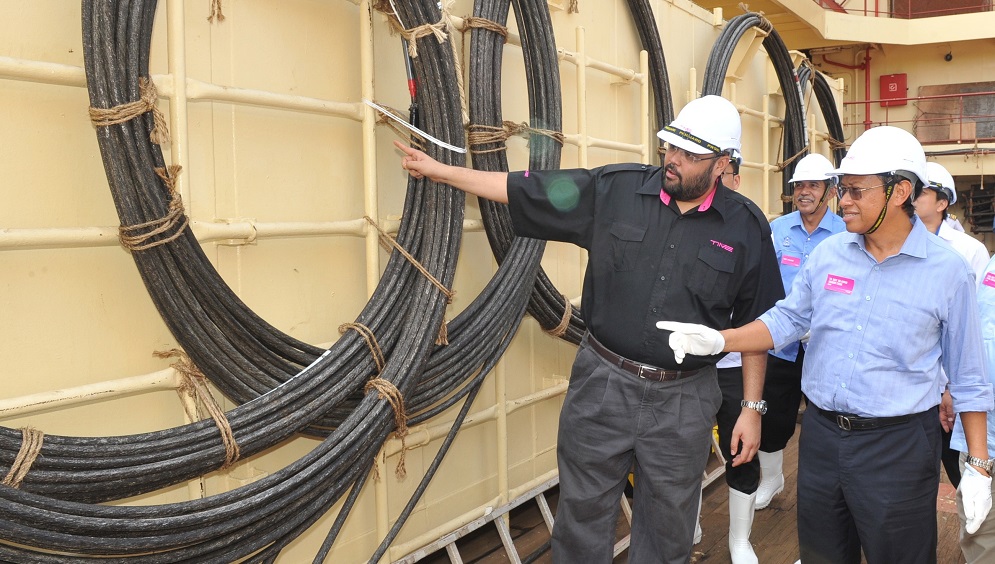Have TIME and TM solved a US$201mil problem?
By Karamjit Singh October 3, 2013
- Competition pushes both to expand international fibre optics infrastructure
- In the process, EPP10 under Communications NKEA could just have been solved

IT seems like TIME dotCom Bhd and Telekom Malaysia Bhd may have inadvertently helped the Malaysian Government cut its expenses by US$201 million (RM650 million).
It all came about by these two telcos competing with each other and with companies in Singapore to offer bandwidth to carriers, service providers and enterprises.
The Performance Management and Delivery Unit of the Prime Minister’s Department (Pemandu), for one, would be pleased that in this case, public funding to the tune of around RM600 million may not be needed to help lower the cost of bandwidth and build a submarine cable system that would strengthen Malaysia’s international connectivity.
That is in fact EPP10 (Entry Point Project) under the Communications, Content and Infrastructure pillar of the Government’s Economic Transformation Programme that seeks to make Malaysia a high-income economy.
That’s because TIME, with an investment of RM180 million into the RM1.8 billion Asia Pacific Gateway (APG) that will be completed in 2014; and Telekom Malaysia (TM) with its undisclosed investments into the Asia Submarine cable Express (ASE) which went live this year; will have helped Malaysia gain critical mass in bandwidth connectivity to Japan.
From Japan, many submarine fibre cables link to the United States where most Internet traffic originates from.
“For us, it is a differentiator as we then control the traffic that flows from Malaysia to Japan and then the United States (via the Unity cable TIME has a 10% stake in), which means we can offer customers Service Level Agreements (SLAs) and guarantees,” says Afzal Abdul Rahim, its chief executive officer.
Beyond TIME’s interest in its fibre cable being ready by 2014, Afzal makes the case that with both APG and ASE landing in Japan by next year, this begins to position Malaysia as a viable transit point for bandwidth to flow from the United States to Asia and vice-versa.
He also sees Internet traffic from Indochina being transported down via Thailand to Cherating in the Malaysian state of Pahang, where the landing station is, and then sent around the world.
This aggregation of data is another reason why Afzal thinks Malaysia can become a natural transit point for international bandwidth.
This will see the beginnings of pricing for bandwidth narrow between Malaysia and Singapore, and see Malaysia become a genuine option for global players which want international bandwidth but also resilience and redundancy when making their choice.
The fact that they will soon have a choice between TIME and TM will also be an attractive feature as previously there was only TM offering international bandwidth out of Kuala Lumpur.
And, naturally, with two Malaysian partly owned cables landing in Japan, TIME and TM will be able to aggregate their demand and get better pricing.
The cost of bandwidth in Malaysia drops too. Currently 1MB of bandwidth costs less than US$10 in Singapore but around US$40 in Malaysia. It is US$0.50 in the United States.
“We [with TM] would have solved the EPP10 without spending any tax dollars,” trumpets Afzal, speaking to journalists after a tour and briefing of the ship that will begin to lay the Malaysian leg of its APG fibre optic cable to Japan. The Malaysian leg will see 1,100km of cable being laid under the ocean.
However, some industry players point out the possibility that the monopoly could just become a duopoly with TIME.

While it is premature to speculate on that, what’s interesting here however is that Konsortium Rangkaian Serantau Sdn Bhd (KRS), the company set up under EPP10 to solve the problem of costly bandwidth and greater international connectivity that is Malaysian-owned, has now changed its strategy.
A look at its website (see illustration) shows that it now aims to justify an 18,500km subsea fibre optic cable between Peninsular Malaysia and the United States, with branch landings in Kuching and Kota Kinabalu.
Geographical positioning is one key reason given:
- It provides a more direct route to the US West Coast without having to traverse through several political and geological hotspots.
- The Straits of Luzon is susceptible to earthquakes, typhoons and undersea landslides.
- Overlapping claims in the South China Sea may affect restoration or maintenance services.
- The narrow waterways around Singapore carry the risk of ship anchor damage.
The second reason is to provide a ‘backup’ capability to other carriers in the region as the Serantau Cable will be taking a completely different route from all other cable systems in the region.
A third is because it does not duplicate nor compete with existing Malaysian based carriers’ cable routes. In fact, it complements and augments their existing offerings.
These plans are still being drawn up and it remains to be seen if KRS will get the support of Pemandu, or even some of its own 24 consortium members. TIME and TM are members. And then of course there is the funding needed.
For more technology news and the latest updates, follow @dnewsasia on Twitter or Like us on Facebook.


